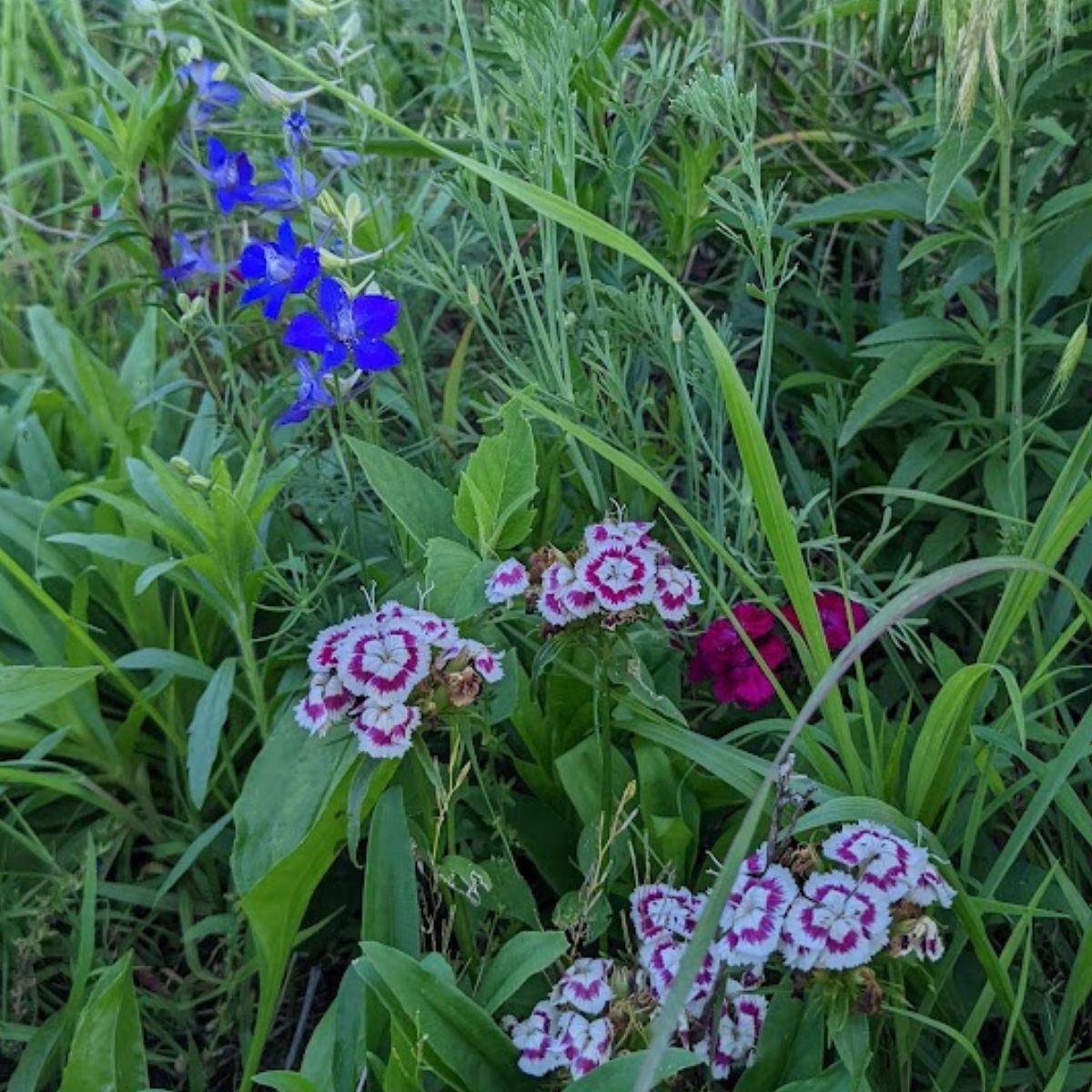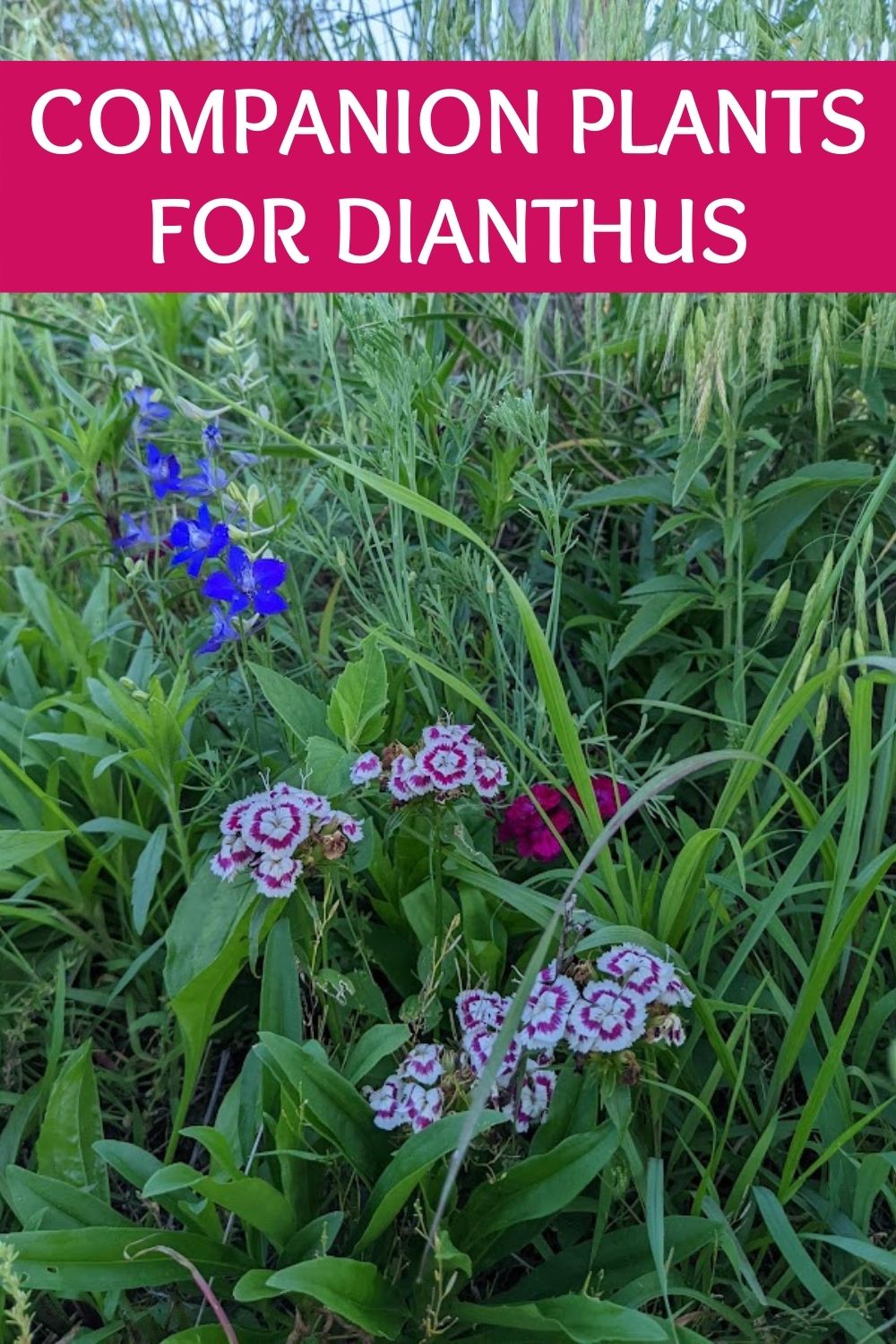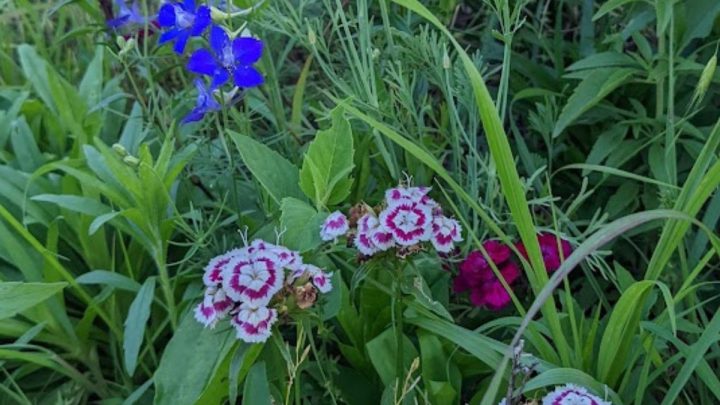Dianthus (Dianthus spp.) includes nearly 350 species of flowering plants. This includes carnations (Dianthus caryophyllus), pinks (Dianthus plumarius), and sweet William (Dianthus barbatus). Pinks and sweet William are common dianthus varieties grown in flowerbeds. Choosing the right companion plants for dianthus will highlight their beauty.

Are Pinks And Sweet William The Same?
Pinks and Sweet William are dianthus plants that are often confused but differ in some significant ways.
Pinks (Dianthus plumarius)
Pinks produce delicate blooms with the traditional ‘pinking’ around the edges. Pinks earned their name from this feature as the petals look like they have been cut with pinking shears. These delightful little flowers bloom atop slender stems held above frilly, blue-gray foliage. Flowers range in color from shades of pink and red to yellow or white with several bi-colored varieties available. Pinks are perennials that return in the same spot each year. They range in height from a mere 6 inches to 18 inches or more, depending on the variety. Blooms may be single or double-petaled. Double petaled pinks resemble miniature carnations.
Sweet William (Dianthus barbatus)
Sweet William produces clusters of blooms held above the foliage on an upright stem. Flowers range in color from red, pink, and white to many delightful bicolors. Petal edges are slightly frilled.
Sweet William can be either a short–lived perennial or a biennial. It typically spreads by self-seeding and may pop up in new areas of the flowerbed each year. It ranges in height from 7 inches to 24 inches, depending on the cultivar.
What Is Companion Planting?
Companion planting is the practice of growing plants together for the mutual benefit of one or both plants. Traditionally, companion planting in the vegetable garden is done to enhance growth, improve flavor, or deter garden pests.
Regarding companion planting with flowers, the mutual benefits can extend to enhancing the beauty of one or both plants. This is often accomplished via the size and shape of the plant; its bloom size, shape, or color; or the characteristics of the foliage.
What Are Good Companion Plants For Dianthus?
The best companion plants for dianthus share the same growing requirements (they like well-drained soil that dries slightly between waterings and enjoy full sun). That being said, it is important to choose flowers and plants that enhance the beauty of your dianthus flowers. While color combinations that appeal to you can be a personal preference, the following plants are an excellent choice to start with.
1. Columbine (Aquilegia)
Columbine blooms in late spring or early summer when your dianthus does. Columbine’s bell-shaped flowers and attractive foliage make a lovely backdrop for dianthus. Choose columbine bloom colors of lavender or purple or deep pinks, to highlight the color of your dianthus blooms.
2. Artemisia (Artemisia spp.)
Artemisia produces a mass of frilly foliage covered with white hairs that give it its characteristic silvery-gray appearance. Artemisia foliage creates an attractive background behind dianthus and highlights your dianthus blooms.
3. Geranium (Geranium spp.)
Both perennial and annual geraniums provide showy blooms and attractive foliage that contrasts nicely with dianthus. Plant geraniums in the background with short dianthus in the foreground for a show of color in early summer.
4. Salvia (Salvia spp.)
Salvia produces spires of flowers from early summer until fall. They range in height from12 to 24 inches with showy blooms in lovely shades of blue, purple, and pink that contrast nicely with dianthus.
5. Lavender (Lavandula spp.)
This perennial herb creates a mound of soft, blue-gray foliage topped with delicate lavender bloom. Both the foliage and the flowers make an attractive background for dianthus.
6. Bleeding hearts (Dicentra spectabilis)
Delicate bleeding hearts bloom on arching stems giving the flowerbed an airy feel. Planting dianthus in front of a tall bleeding heart enhances the beauty of each.
7. Daisies (Leucanthemum vulgare or L. ×superbum)
Free-flowing daisies seem to dance in the breeze, making them the perfect complement to your dianthus. Choose pure white daisies to make to color in your dianthus blooms pop.
8. Roses (Rosa spp.)
Roses are the mainstay of cottage gardens and make a delightful companion for dianthus. Plant the dianthus under rose bushes for a showy splash of color.
9. Russian sage (Perovskia atriplicifolia)
Russian sage looks like lavender but blooms all summer. Plant shorter dianthus in front of Russian sage with its lovely blue-gray foliage and lavender blooms.
FAQs About Dianthus Companions
Can I plant dianthus in the vegetable garden?
While you can certainly grow dianthus in your vegetable garden if you are short on space and want to use them as cut flowers, keep in mind that many garden vegetables are massive by the end of the summer and may overrun your dianthus. If you choose to grow dianthus in your vegetable garden, plant them along the edges of tuck them into empty spaces where they will have room to grow.
Large vegetable plants, like cucumbers and squash, will likely overtake your dianthus plants, making them nearly invisible. They may also rob your dianthus plants of the nutrients they need or block out the sun leaving you with weak, spindly dianthus plants.
Can dianthus and herbs be planted together?
Dianthus can be planted with herbs as long as they have room to grow and receive plenty of sunlight. Cottage gardens often contain both herbs and flowers and typically feature old-fashioned flowers like dianthus.
Consider the height of the herbs and your specific dianthus plants when you plant them together to ensure that your flowers are visible.
Are there plants you shouldn’t plant with dianthus?
Not all plants play nice with the dianthus flowers. See which types of plants you should avoid mixing with dianthus.
Plants that will shade or crowd them
Dianthus needs plenty of sunlight and room to grow. Planting them near plants that will shade them or don’t allow them the space they need to grow will likely inhibit their growth and reduce blooming.
Plants that have different watering needs
Dianthus prefers well-drained soil that dries out slightly between watering. If the soil stays wet, dianthus is susceptible to crown rot. Planting them will plants that like rich, wet soil makes it difficult for the plants to get their needs met. Likewise, planting dianthus with plants that thrive in arid soil can be a recipe for disaster, as your dianthus will suffer without adequate water.
Plants with different sunlight requirements
Dianthus prefers full sun but will grow in partial shade. However, planting them in a shade garden with other shade-loving plants may prevent your dianthus from blooming.
Plants with blooms that clash with the color of your dianthus
Just because a plant has the same water and sunlight requirements doesn’t make it a good companion plant for dianthus. Plants with blooms in reds, orange, or yellow may not be the best choice to enhance the beauty of your dianthus blooms. Always consider the color of the flowers when choosing companion plants for dianthus.
Dianthus Companion Plants – Conclusion
Choosing good companion plants for your dianthus plants is important. This includes choosing flowers and foliage plants that have the same basic growing requirements, but that is not the only concern. You need to choose plant companions for your dianthus that will enhance the beauty of your garden. Keep the overall size of your mature plants, the foliage color and shape, and the color of the blooms in mind, too. Always plant the shortest plants in the foreground with taller plants behind them so the flowers will be visible when they bloom.















Companion Planting Guide (Including 7 Benefits Of Polyculture)
Monday 8th of August 2022
[…] Companion plants for dianthus […]